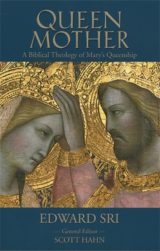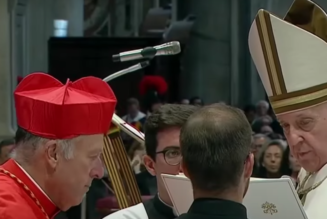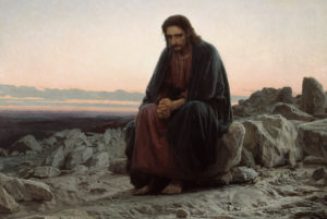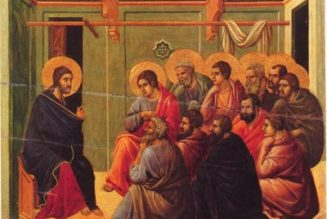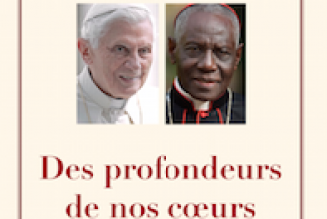By Clement Harrold

For many Protestants, devotion to Our Lady is the single biggest obstacle to their becoming Catholic. Even many Catholics admit that they struggle with relating to Mary, or fail to understand why the Church seems so obsessed with her. Underlying this confusion might be a simple question which lurks behind all the others: If Catholics are right about Mary, then why on earth does the New Testament hardly ever mention her?
This question can present a considerable intellectual roadblock for Catholics and Protestants alike. Sure, there might be (according to Catholics, at least) some clever exegetical arguments that show the reasonableness of the Immaculate Conception or the Perpetual Virginity. But it feels as if that approach still sidesteps the much bigger challenge, namely, Mary’s near-total absence in Scripture. Again, if she’s so important, then why is she mentioned so little?
Here we need to push back a bit. Contrary to popular belief, it is not the case that Our Lady barely appears in the Bible. She actually appears multiple times in all four Gospels, and she is depicted as an important figure not only at Jesus’s conception and birth, but also at His first miracle and at His crucifixion. In the Acts of the Apostles, moreover, she is shown to be present in the Upper Room at Pentecost, and a robust case can be made that she is the heavenly queen figure described in Revelation 12.
Now admittedly, Mary is largely absent from the New Testament epistles, but this can hardly be construed as a strike against the Catholic view. For one thing, there are many important doctrines and devotions which St. Paul and the other letter writers simply don’t address. The doctrine of the divinity of the Holy Spirit, for example, isn’t stated explicitly anywhere in the New Testament epistles, but nonetheless it’s a doctrine we should accept based on a reading of the Scriptures as a whole, especially as interpreted through the living tradition of the Church.
Another point worth remembering here is that many of the New Testament epistles were written before the Gospels, and so when we look at the New Testament as a whole, it’s actually the later books like Luke, Acts, John, and Revelation which give us the final word on Our Lady—and in all these books, she plays a major role!
This gets to another basic point, which is that oftentimes quality matters more than quantity when it comes to interpreting Scripture. What is important is not so much the number of times something is alluded to, but rather the way in which it is presented. Applying this rubric to Our Lady, we quickly discover that she is time and again portrayed as a figure of enormous significance. (Although we haven’t the space here to develop the Marian biblical evidence in detail, the reader is encouraged to explore these issues further via the reading suggestions listed below.)
Drawing on the deep connections between Old and New Testaments, biblical scholar Brant Pitre has persuasively shown how both Luke and John go out of their way to highlight Mary as the “New Eve,” that is, as the prophesied woman of Genesis 3:15, whose radical “yes” to God serves to undo the sin of Eve. When understood through this lens, the Gospel texts that mention Mary are suddenly infused with new meaning. For instance, Jesus’s decision to address her as “woman” at the wedding feast at Cana (see Jn 2:4), or at Calvary (see Jn 19:26), is a direct reference to the Genesis 3:15 passage.
What a close reading of the Marian texts often reveals, therefore, is that those passages which appear to only mention Mary in a brief or cursory fashion are in fact theologically loaded statements about the pivotal role God has asked her to play in salvation history. We find other rich examples in places like Luke 1, where Mary is described by the angel Gabriel as “full of grace” (Lk 1:28), or by Elizabeth as “blessed among women” (Lk 1:42). These are not normal epithets!
Notice especially how Gabriel does not say, “Hail, you who are full of grace,” but simply, “Hail, full of grace, the Lord is with you!” In other words, the term for “full of grace” (kecharitomene in Greek, meaning something like “having been filled to the brim with grace”) is used not just to describe Mary, but rather to denote her very identity. That’s pretty significant! Likewise, “blessed among women” is a Hebrew form of the superlative, meaning “the most blessed of women.”
St. Luke is also careful to record the title “the mother of my Lord” (Lk 1:43), which Elizabeth applies to Mary. Scholars see this as significant because in Luke’s writings, the appellation “Lord” is used interchangeably with “God.” Hence the decision of the early Church to refer to Mary as Theotokos, or “Mother of God,” already finds support in the Gospels.
Other Marian texts with far-reaching implications are those which depict her as the new Ark of the Covenant. Just as the Ark in the Old Testament was the dwelling place of God, so too in the New Testament Mary becomes the living tabernacle in which the Holy Trinity abides. Just as God’s dwelling place in the Old Testament was covered by the cloud of glory (see Ex 24:15-16; 40:34-38; 1 Kgs 8:10), likewise Mary is told that she will be overshadowed by the Holy Spirit (see Lk 1:35).
Similarly, when Luke drops the ostensibly random detail that after the visitation Mary stayed with Elizabeth for “about three months” (Lk 1:56), he is clearly making a reference to 2 Samuel 6:11, where the Ark is described as staying in the house of Obed-Edom for three months. And just as King David leaped for joy before this Ark (see 2 Sam 6:15-16), likewise John the Baptist leaps for joy in Elizabeth’s womb when he hears Mary’s voice (see Lk 1:41-42).
In the book of Revelation, the identification of Mary as the new Ark of the Covenant is made more or less explicit. Compare side-by-side the final verse of chapter 11 and the first two verses of chapter 12:
Then God’s temple in heaven was opened, and the ark of his covenant was seen within his temple; and there were flashes of lightning, loud noises, peals of thunder, an earthquake, and heavy hail. And a great portent appeared in heaven, a woman clothed with the sun, with the moon under her feet, and on her head a crown of twelve stars; she was with child and she cried out in her pangs of birth, in anguish for delivery. (Rev 11:19-12:1-2)
While Protestant commentators often try to interpret the woman in this passage as being Israel or the Church, it is obvious that she can also be understood to be Mary, for the simple reason that she is giving birth to the God-Man (see Rev 12:5)! But if this is Mary, then the close connection between her and the Ark seems undeniable.
Needless to say, much more can be said about all of these issues. The purpose of this article is not to end all exegetical arguments about Mary’s role, but simply to answer the question of why she isn’t mentioned more often in Scripture. To that end, we should realize, first, that she is actually mentioned quite a bit in the Gospels; and secondly, that the way in which she is presented in the Gospels (and in Acts and Revelation) is massively significant.
Lest we forget, Mary is the one whose perfect submission to the will of God helps undo the sin of Eve (see Lk 1:38), the one is filled with grace (see Lk 1:28), the one who is overshadowed by the Holy Spirit (see Lk 1:34), the one who is most blessed among women (see Lk 1:42), the one whom all generations will call blessed (see Lk 1:48), the one whose maternal heart moves Jesus to begin His ministry (see Jn 2:5), the one whom Jesus assigns as a mother to His most cherished disciple (see Jn 19:27), and the one who is portrayed as a spiritual mother to all believers (see Rev 12:17).
In short, Mary receives a far more elevated status than any other human figure in the Bible; and as such, she ought to be taken seriously by all Christians.
Further Reading:
Scott Hahn, Hail, Holy Queen: The Mother of God in the Word of God (Image, 2006)
John Paul II, Redemptoris Mater (1987)
Brant Pitre, Jesus and the Jewish Roots of Mary: Unveiling the Mother of the Messiah (Image, 2018)
Joseph Ratzinger, Daughter Zion: Meditations on the Church’s Marian Belief (Ignatius Press, 1983)
Tim Staples, Behold Your Mother: A Biblical and Historical Defense of the Marian Doctrines (Catholic Answers Press, 2017)
Clement Harrold is a graduate student in theology at the University of Notre Dame. His writings have appeared in First Things, Church Life Journal, Crisis Magazine, and the Washington Examiner. He earned his bachelor’s degree from Franciscan University of Steubenville in 2021.
You Might Also Like
Queen Mother: A Biblical Theology of Mary’s Queenship by Edward P. Sri sets out to explain the firm foundation of Marian dogma in Scripture and Tradition. As Pope Pius VII writes in Ad Caeli Reginam, in which he instituted the first Feast of the Queenship in October 1954: “The arguments on which Mary’s queenly dignity is based have already been clearly set forth, and are to be found in ancient documents of the Church and in the books of the sacred liturgy.”
Based on Sri’s doctoral dissertation, Queen Mother explores the role of the queen mother in the Davidic kingdom, examining the ways in which this theme sheds light on Mary’s role as heavenly Queen and Mother of the Church. As he proceeds through the New Testament, Sri demonstrates the ultimate convergence of the queen-mother theme in the Gospels and the Book of Revelation.

